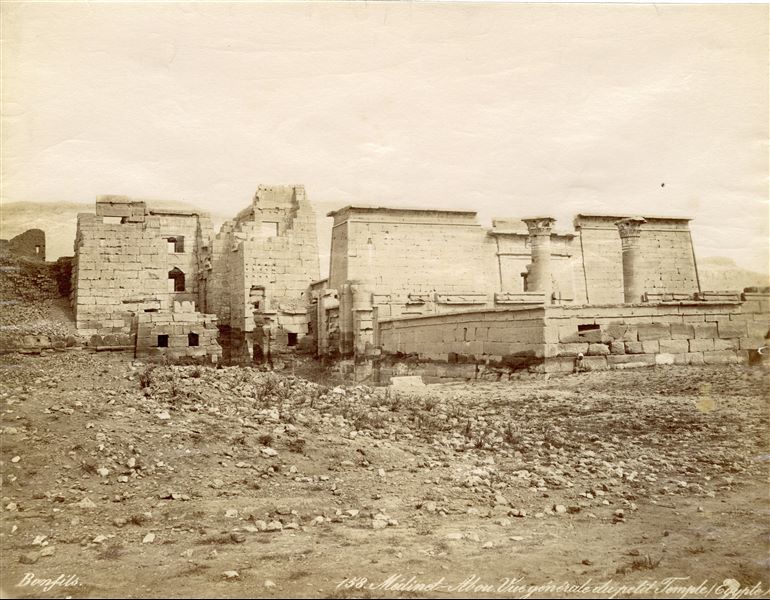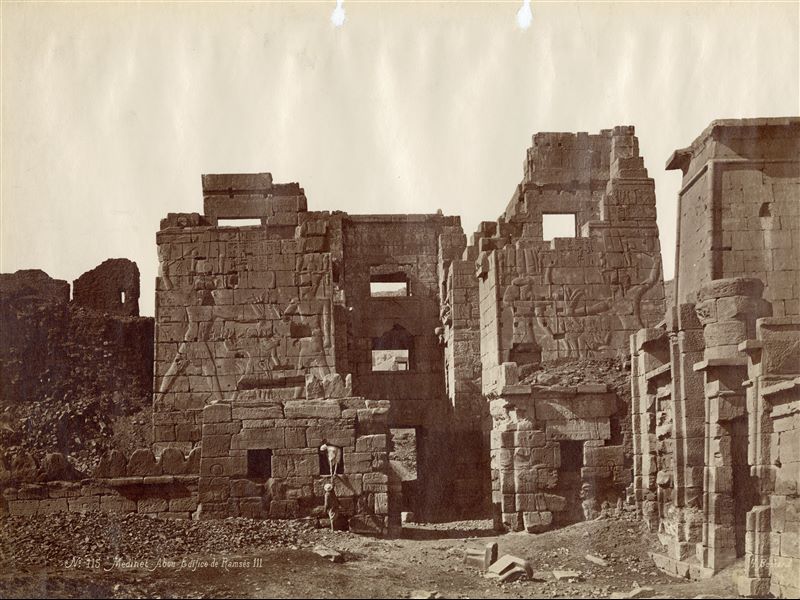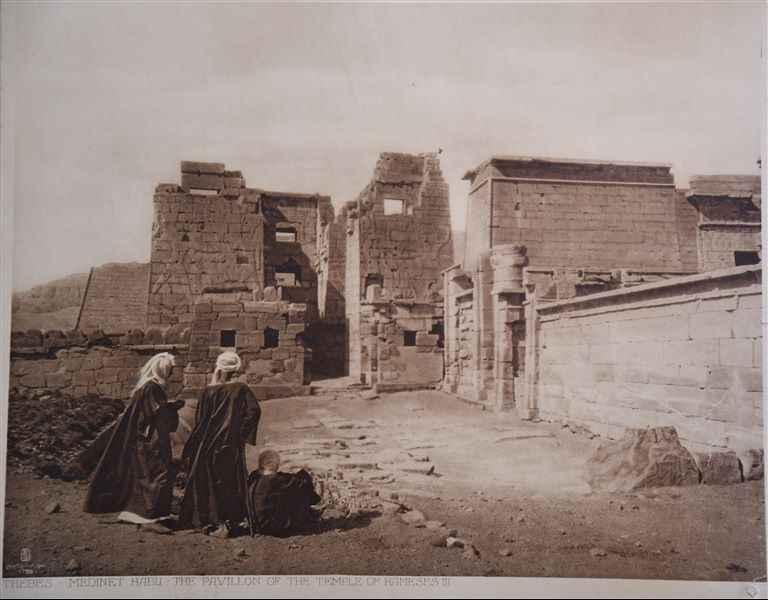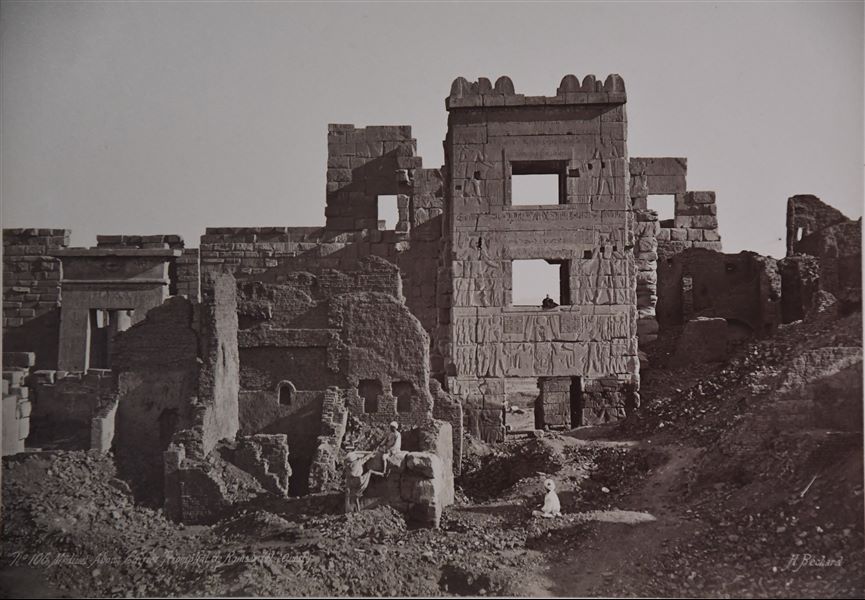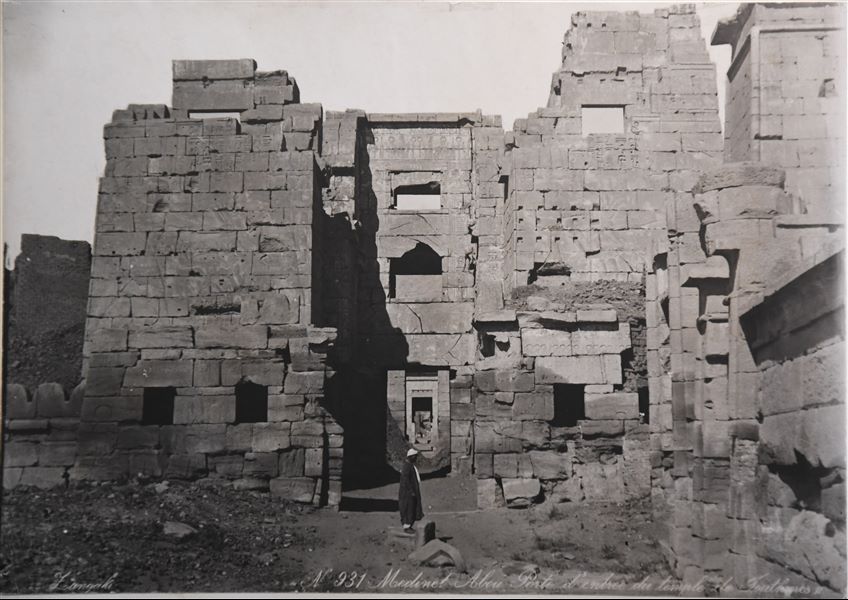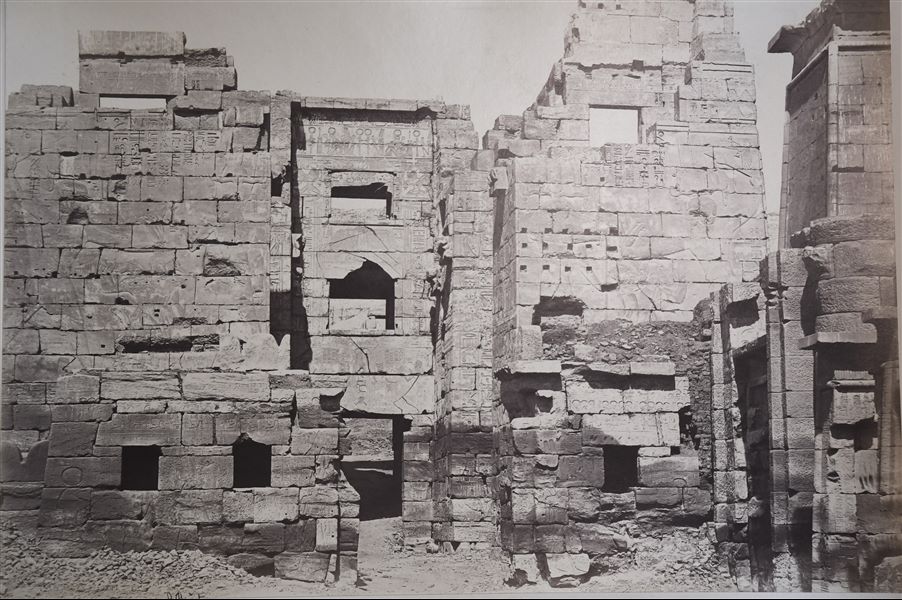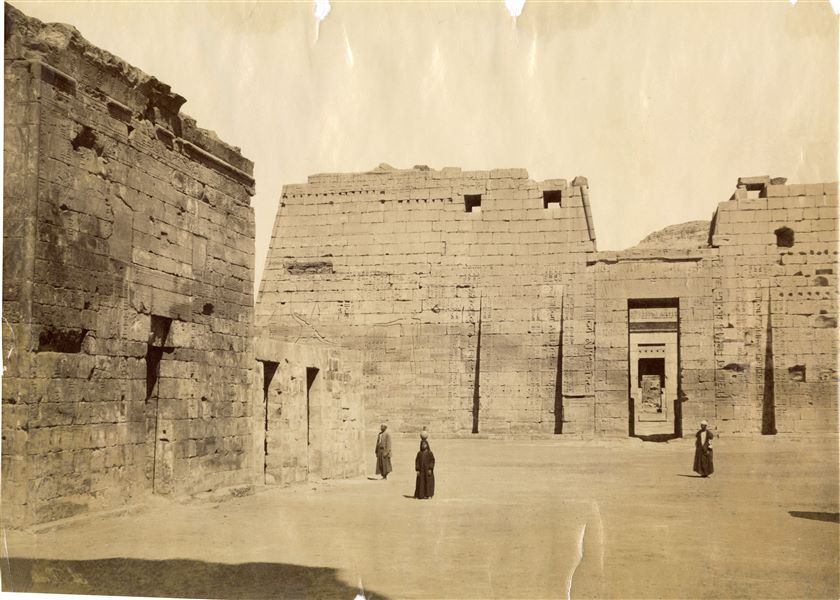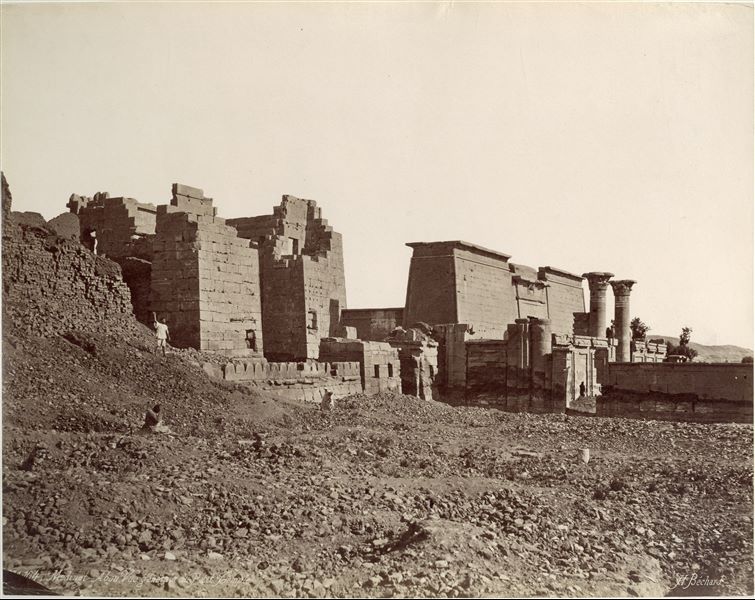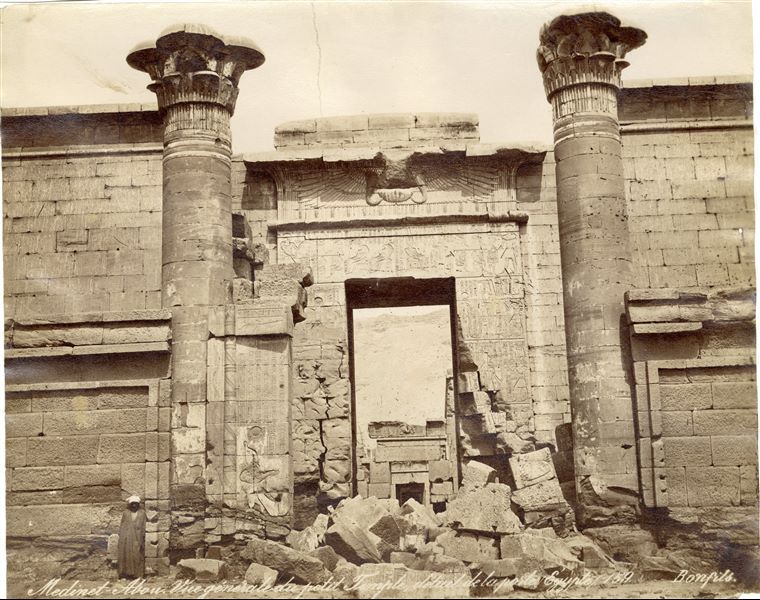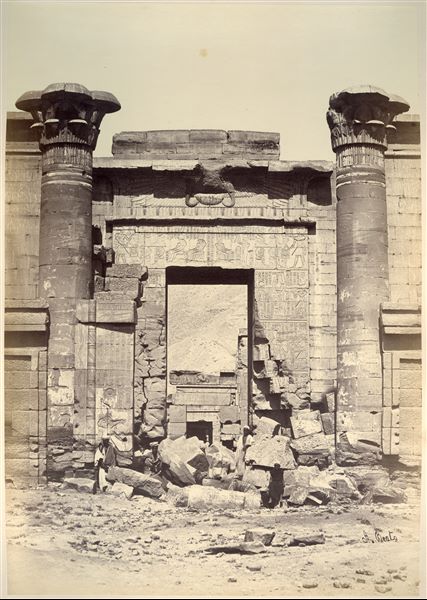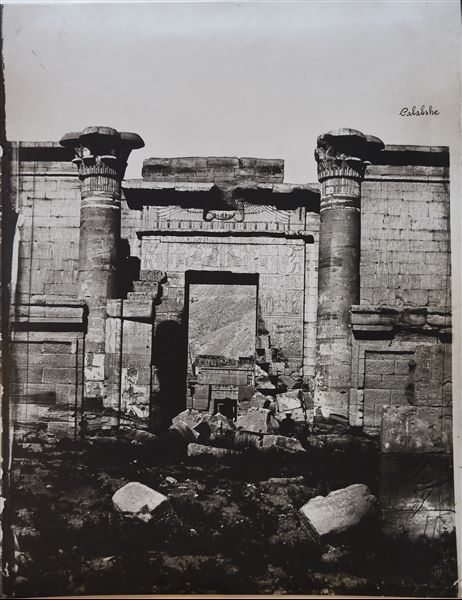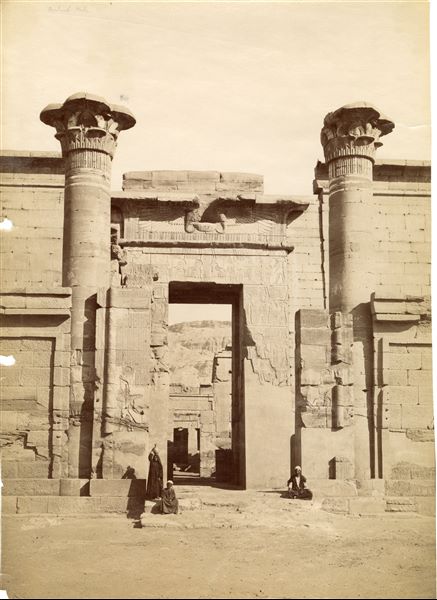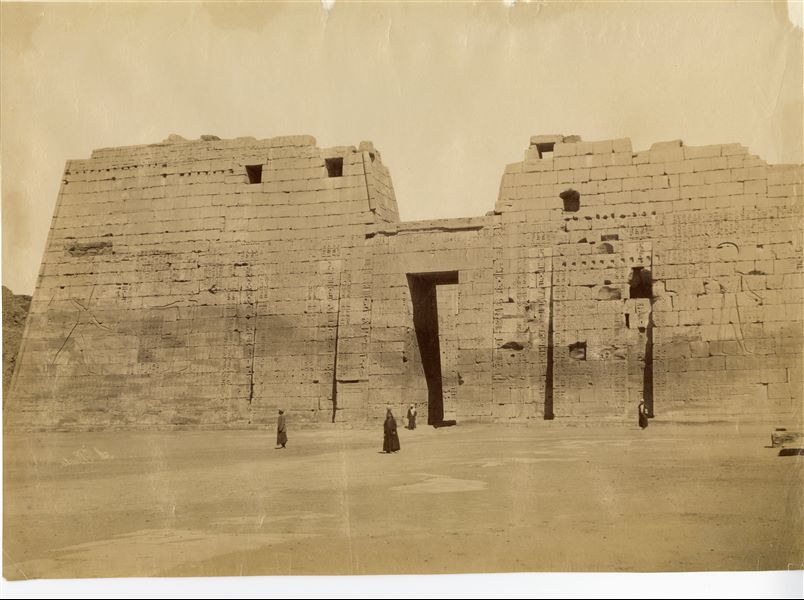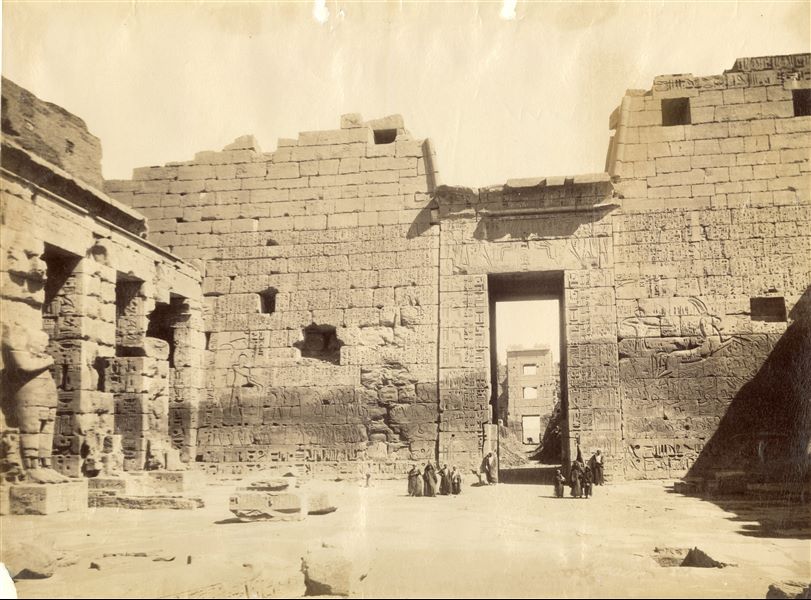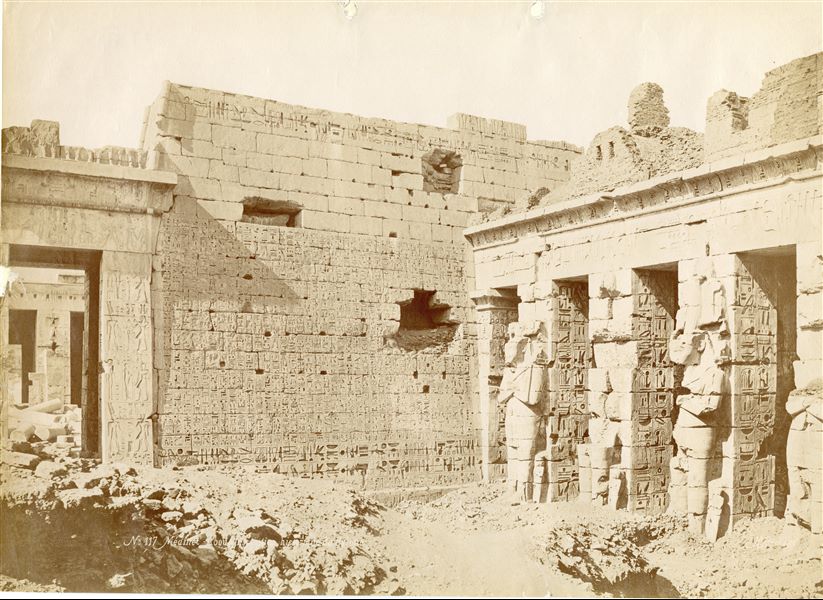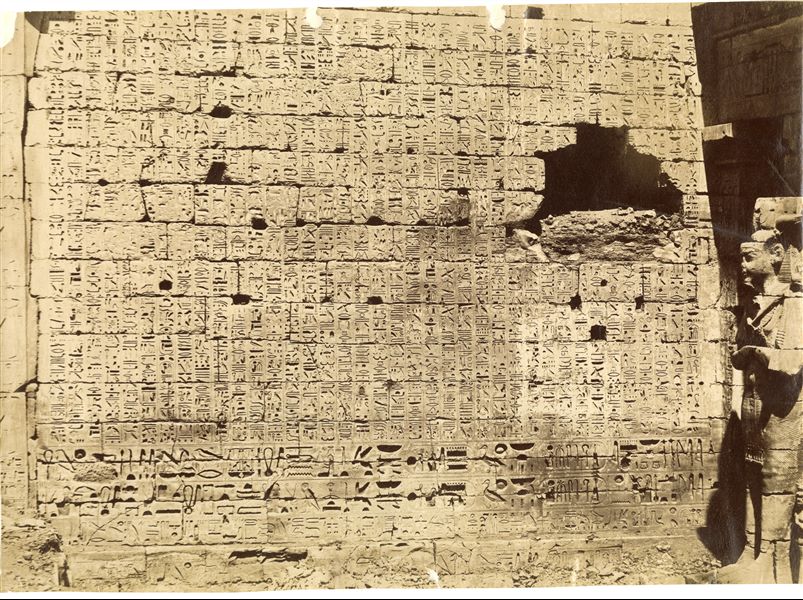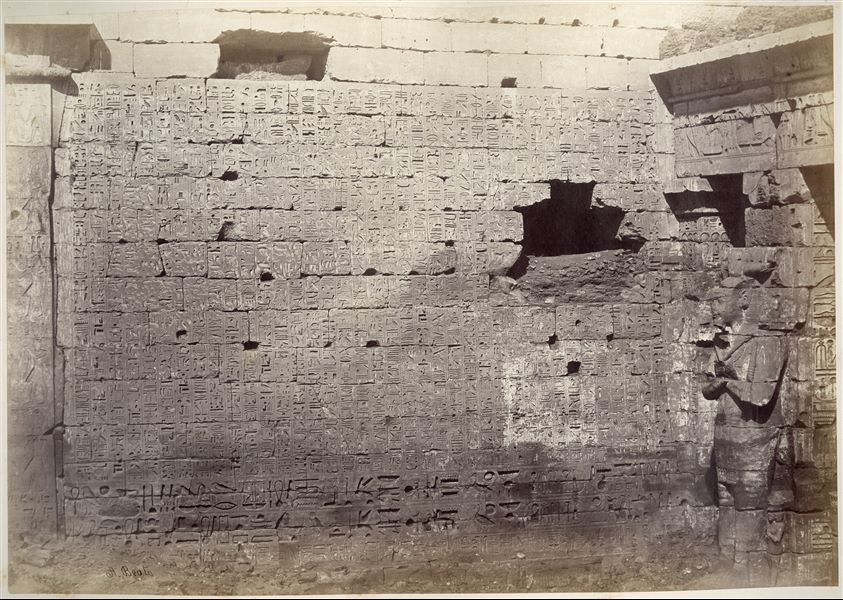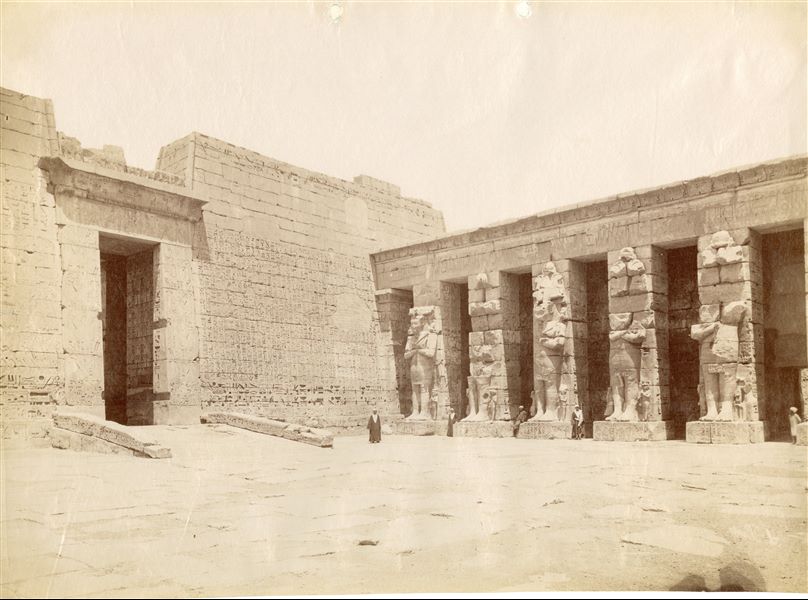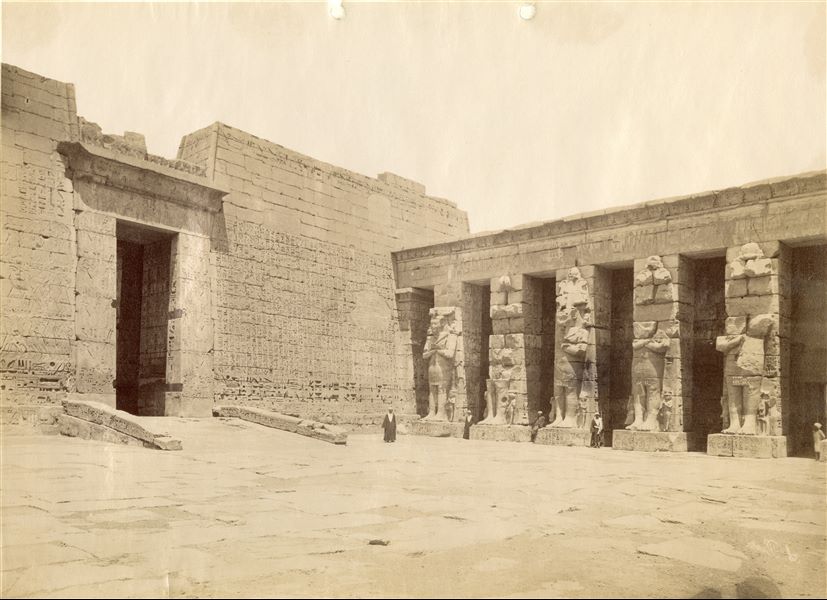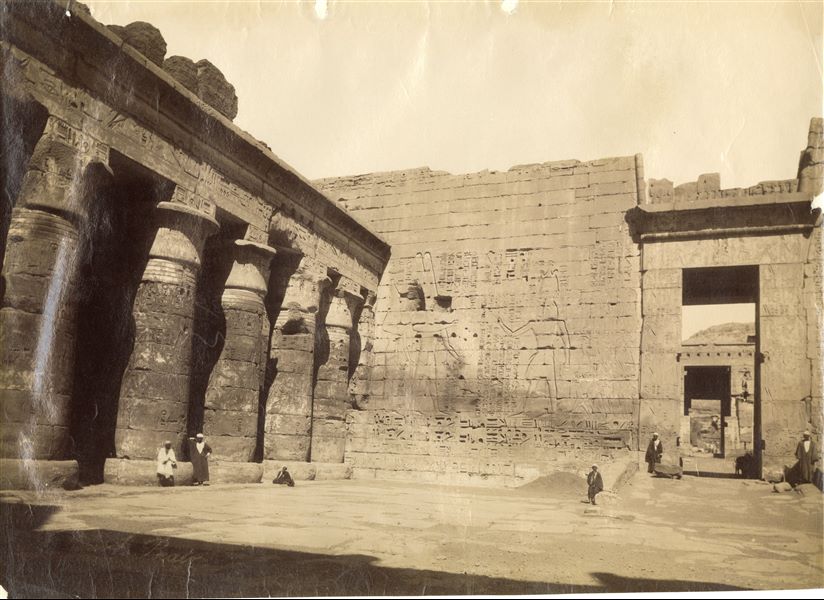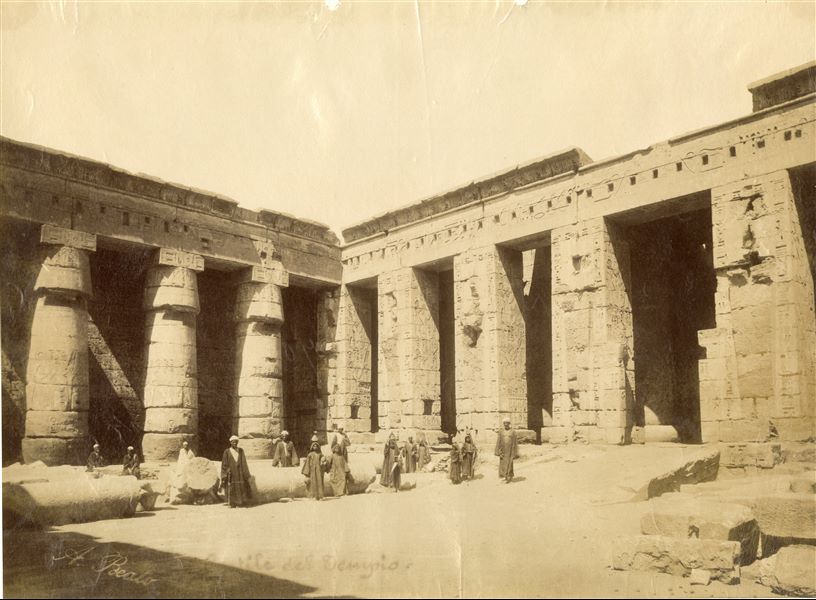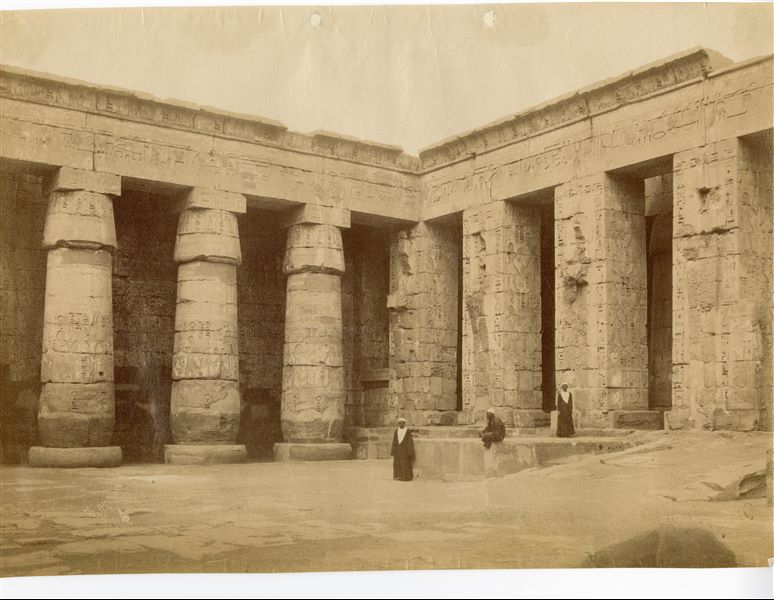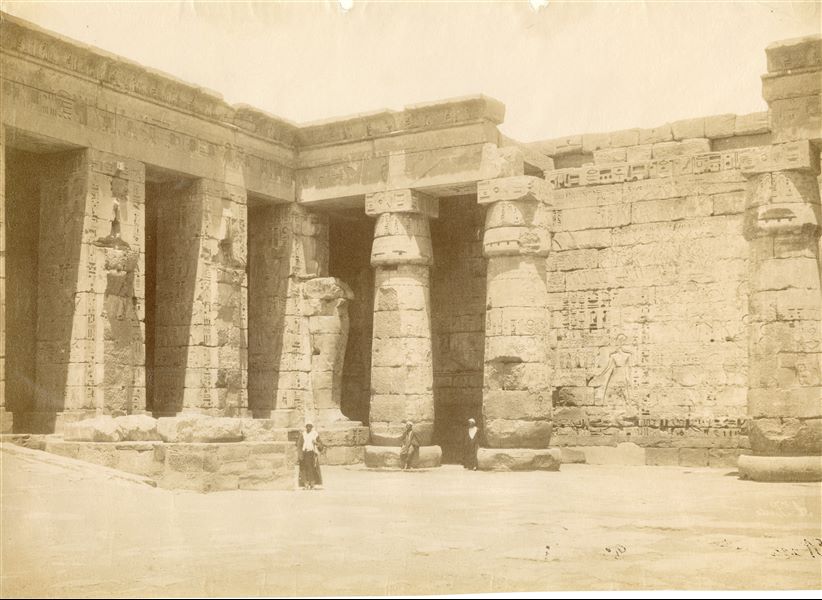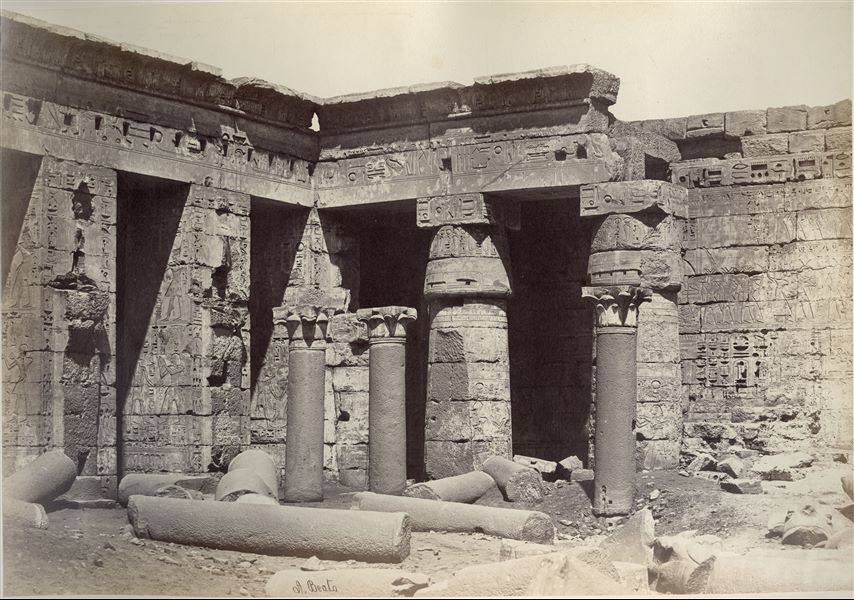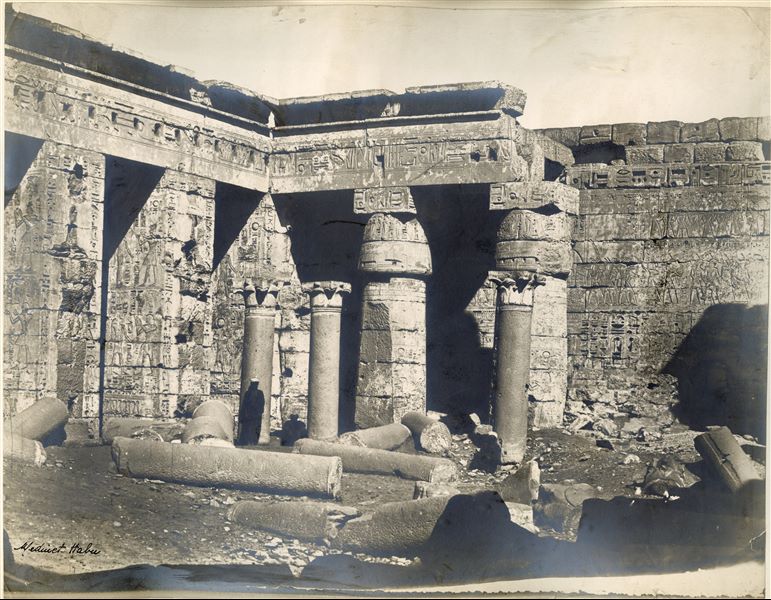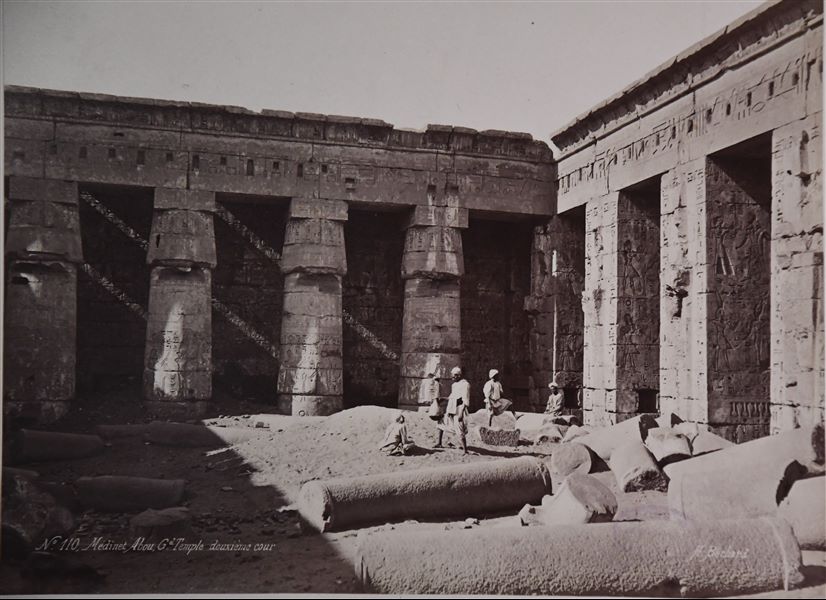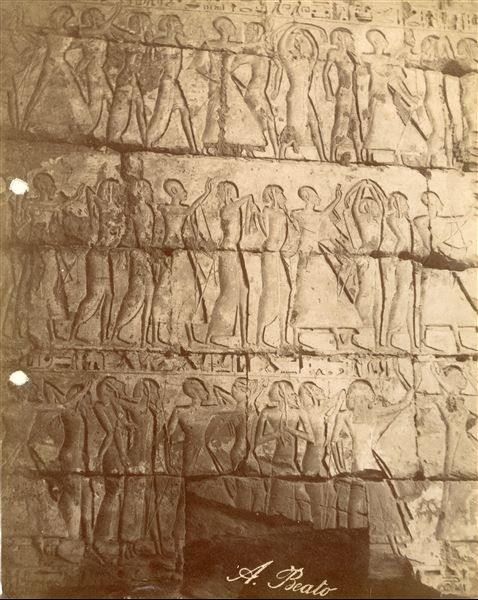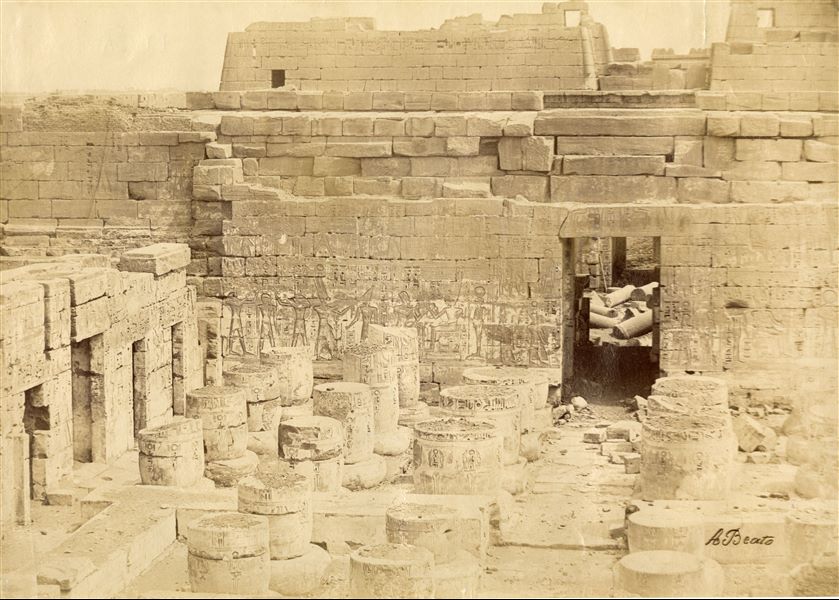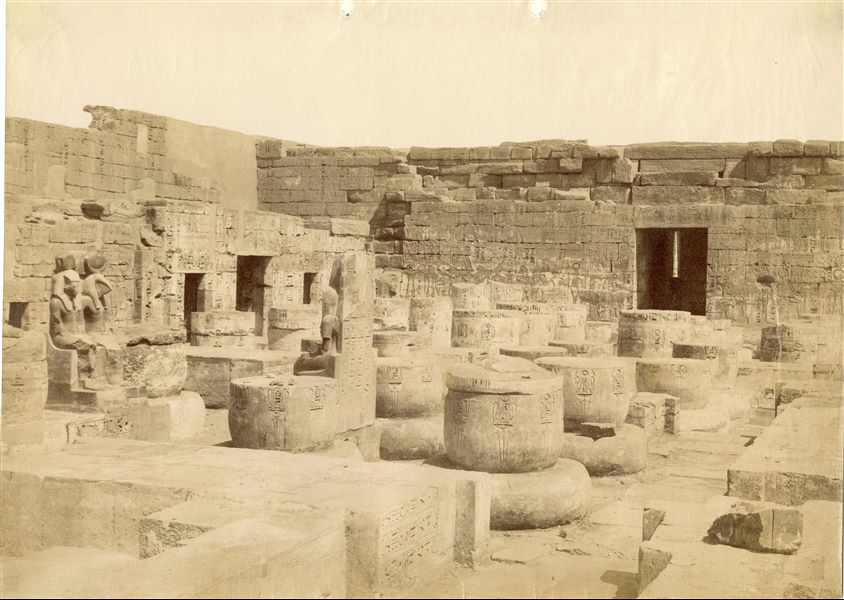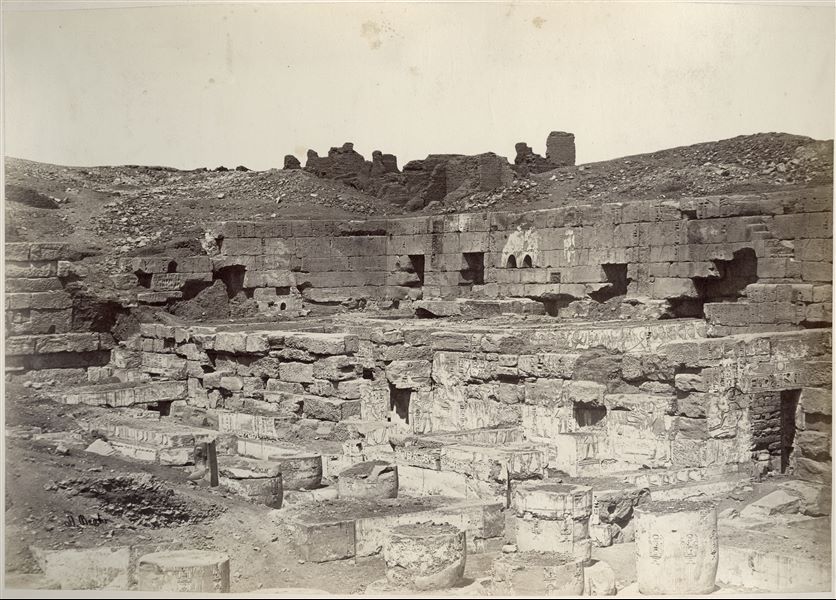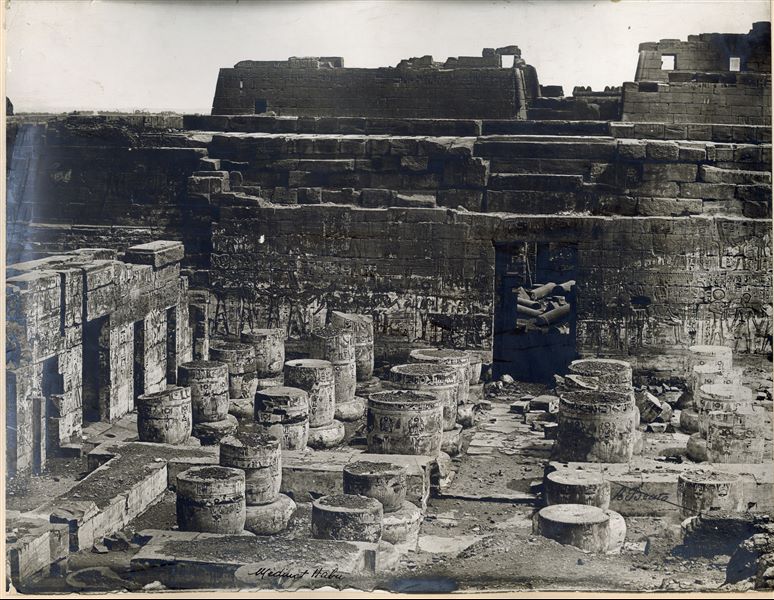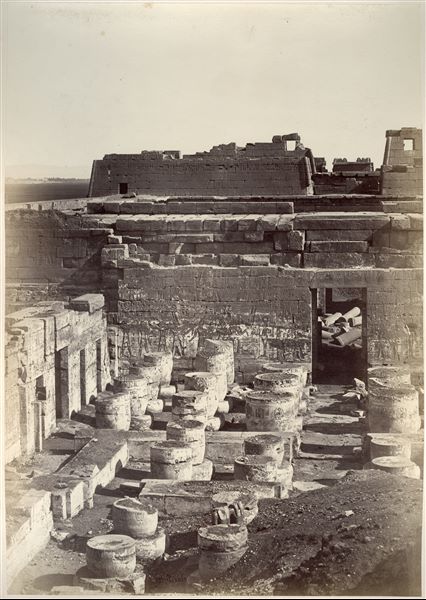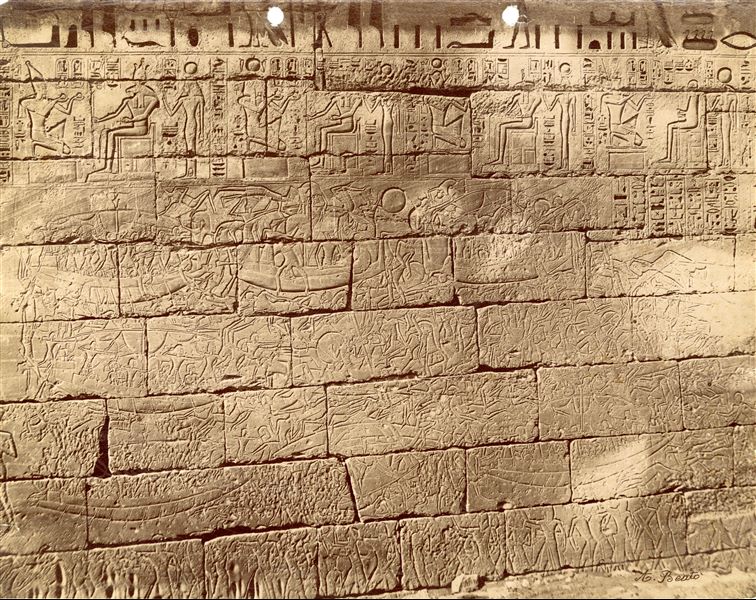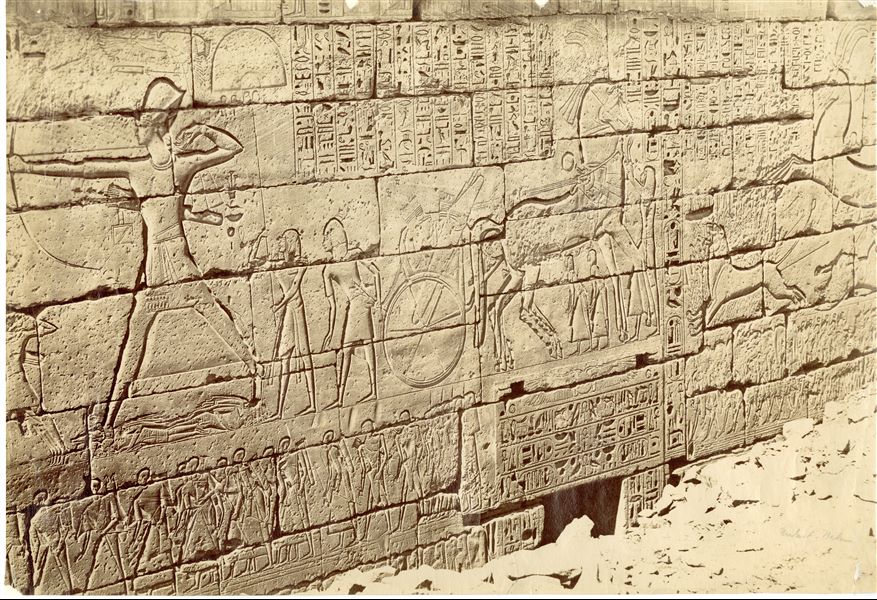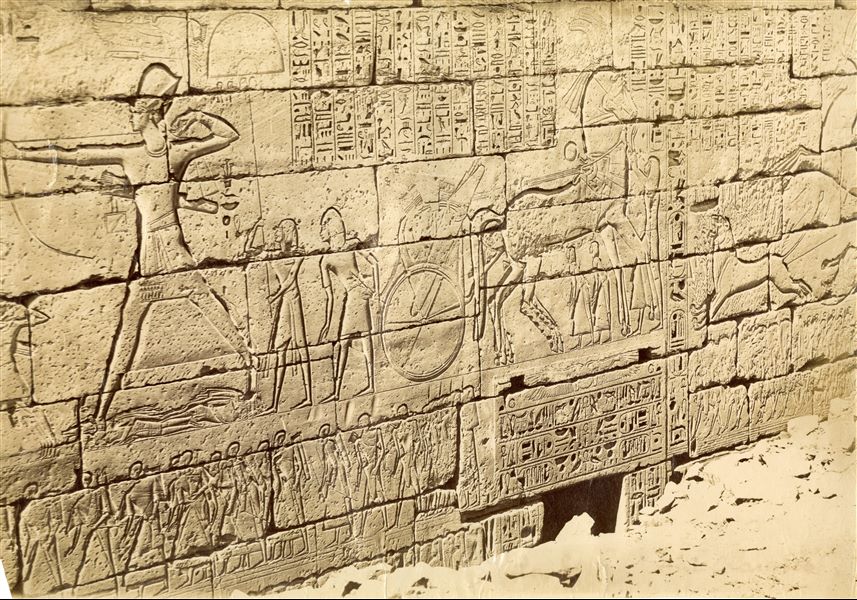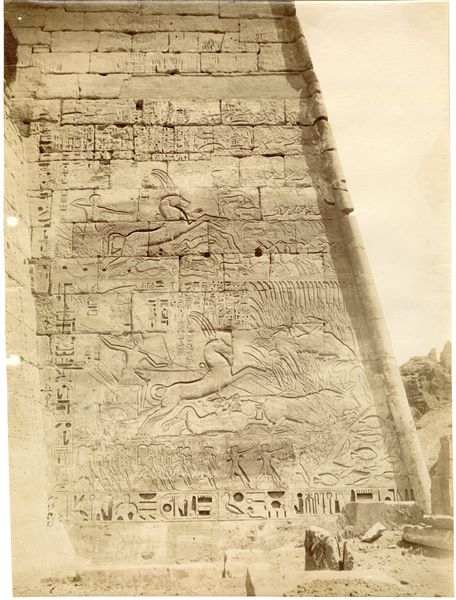View of the structures in front of the Funerary Temple of Ramesses III at Medinet Habu in West Thebes, namely, the monumental entrance with the migdol (left) and the Ptolemaic façade of the Small Temple built in the 18th Dynasty (right). The author’s signature is at the bottom left.
The photograph depicts an overall view of the entrance to the Temple of Medinet Habu, built by Ramesses III. In particular, on the left is the migdol - the architectural structure reminiscent of a syrian fortress, while on the right, is the smaller temple from the 18th Dynasty, which was later incorporated into the Medinet Habu complex. The image can be attributed to Antonio Beato.
The photograph shows the entrance to the Funerary Temple of Ramesses III at Medinet Habu. The gateway has the architectural features of a migdol, a syrian fortress. The author’s signature is at the bottom right.
View of the entrance gate of the Medinet Habu temple, known as the migdol, a fortified gate-house of Near Eastern inspiration. On the right, the Small Temple of the 18th Dynasty, which was later incorporated into the temple complex.
View of the monumental entrance to the Temple of Medinet Habu, built by Pharaoh Ramesses III. The ground level still partially covers the lower part of the ancient building, also called a migdol (fortified tower of Near Eastern inspiration). Photograph taken in the direction of the exterior part of the building, with the first (entrance) pylon of the temple behind it. The author's signature is at the bottom right.
Photograph of the entrance gate to the Medinet Habu temple, know as the migdol, the fortified gate-house of Near Eastern inspiration. The author's signature is at the bottom left.
Photograph of the entrance gate of the Medinet Habu temple, know as the migdol, the fortified gate-house of Near Eastern inspiration. The author's signature (cut off) is at the bottom left.
The photograph shows the first pylon of the Temple of Ramesses III at Medinet Habu, in an axial view (along the axis, the second pylon and the innermost rooms are visible). The author's signature is written in mirror image at the bottom left.
General view of the Small Temple of Medinet Habu, erected earlier in the 18th Dynasty and later incorporated into the complex developed for the main temple. The author's signature can be found at the bottom right.
The photograph shows the entrance to the first courtyard of the so-called “Small Temple” from the 18th Dynasty. It is inside the enclosure of the Temple of Medinet Habu, on the west bank of the Nile in West Thebes, built by Pharaoh Ramesses III in the 20th Dynasty. Photograph taken before cleaning and restoration works The author's signature can be found at the bottom right.
Entrance to the Small Temple of Medinet Habu, built in the 18th Dynasty and later incorporated into the main temple complex.
The photograph shows the entrance gate of the Small Temple, erected in the 18th Dynasty within the Medinet Habu complex (complex built by Pharaoh Ramesses III). The image incorrectly states that this is the Temple of Kalabsha.
The photograph shows three locals standing in front of the entrance to the so-called “Small Temple” from the 18th Dynasty, within the enclosure of the temple of Medinet Habu in West Thebes, built by the 20th Dynasty Pharaoh Ramesses III. The entrance gates, however, were built in the Late and Ptolemaic Periods. Photograph taken after the cleaning and restoration of the gate. The author's signature is at the bottom left, in mirror image.
The photograph shows a view from inside the entrance gate of the Temple of Ramesses III at Medinet Habu, a structure that reflects a migdol, a fortress of syrian origin. Photograph taken from the temple’s first pylon. The author's mirrored signature (almost completely erased) is on the left.
View of the first pylon of the Temple of Medinet Habu, built by Pharaoh Ramesses III. The author's mirrored signature is on the left.
The photograph shows a detail of the decoration of the left side of the entrance pylon of the Temple of Medinet Habu, built by Pharaoh Ramesses III. The ruler wields a mace to strike down enemies whilst holding them by the hair with his left hand. This is a typical decorative theme portryed on temple exteriors. The author's signature can be found in the bottom right, in a mirror-like handwriting, and is almost illegible.
The photograph shows the rear (western) façade of the first pylon of The temple of Medinet Habu in West Thebes photographed from the first courtyard, with locals nearby. Through the gateway, the watchtower is visible, a structure named after the syrian fortresses of the time called a migdol. The author's signature is almost illegible, but present at the bottom right-hand corner.
The photograph depicts the north-eastern side of the first courtyard of the temple complex of Medinet Habu in West Thebes, built by Ramesses III. Here the statues leaning against the pillars of Pharaoh Ramesses III stand out. Two locals position themselves to show the colossal size of the statues. Towards the left side, the photograph is slightly blurred.
The photograph shows the east façade (north side) of the second pylon of the Temple of Medinet Habu in West Thebes, built by Ramesses III, and the first courtyard of the temple. Note that the original ground level is still covered by sand and debris, which cover the bases of the statues and form an uneven surface in the courtyard. The author's signature is at the bottom right.
View of the first court in The temple of Medinet Habu, built by Pharaoh Ramesses III on the west bank of the Nile at Thebes. The still partially buried Osiride pillars show that the date of the shot predates the cleaning and restoration work on site. The author's signature is at the bottom right.
The photo shows a close-up of the texts on the second pylon from the Temple of Ramesses III at Medinet Habu, photographed from the first courtyard. One of the colossal Osiride pillars of the colonnade to the north can also be seen on the right.
Photograph of the front wall of the second pylon from the Temple of Medinet Habu. One of the Osiride pillars can be seen on the right. The author's signature can be found at the bottom right.
View of the northwest corner of the first courtyard in The Temple of Medinet Habu on the west bank of Thebes built by Ramesses III, and the front façade of the second pylon. The photograph shows the signature of the author, in the lower right corner in a mirror-like way and is very illegible.
The photograph shows the north-west corner of the first courtyard, with the second pylon’s entrance of the Temple of Medinet Habu in West Thebes, built by Pharaoh Ramesses III. The author's mirrored signature can be found at the bottom right.
The image shows a view of the northern colonnade in the first courtyard of Medinet Habu, with the Osiride pillars leaning against some columns, not yet fully cleared of sand and debris.
The photograph shows a detail of the decoration of the the first courtyard’s western side in the Temple of Ramesses III at Medinet Habu, West Thebes. It shows a group of prisoners in a row carried by the pharaoh in front of Amun and Mut (who are not visible in this image).
The photograph (datable to before the restoration) shows the front (eastern) façade of the second pylon of the Temple of Medinet Habu, built by Pharaoh Ramesses III. It is decorated with the scene of offering captives by the ruler to the gods Amun and Mut. Photograph taken from the first pylon. The author's signature is visble at the bottom left.
Close-up view of the entrance to the second courtyard of the Funerary Temple of Medinet Habu, built by Pharaoh Ramesses III, with a group of local inhabitants posing for the photographer. The author's signature is at the bottom left.
Axial view of the Temple of Ramesses III at Medinet Habu, from the second courtyard in the direction of the temple entrance. A number of columns are still present in the courtyard, some standing, others on the ground. Along the central axis is the entrance to the first pillar and the migdol a the back. A group of people pose for the photographer in the shadow of the monumental pillars.
The photograph shows the south-eastern corner of the second courtyard of the Temple of Medinet Habu, built by Pharaoh Ramesses III, with some local inhabitants looking towards the camera lens. The courtyard still has several columns on the ground. This factor allows for this image to predate photograph Inv11_004. The author's signature is at the bottom left.
The photograph shows the south-east corner of the second courtyard of the Temple of Medinet Habu, built by Pharaoh Ramesses III, with three local inhabitants looking towards the lens. The author's signature is placed (in a mirror image) at the bottom left.
The photograph shows a view of the north-eastern corner of the second courtyard of the Temple of Medinet Habu in West Thebes, built by Ramesses III, with three locals posing for the camera between the columns, which are cut and still on the ground in the middle of the courtyard before it was cleared. The author's signature is at the bottom right.
The photograph shows the north-eastern corner of the second courtyard of the Temple of Medinet Habu, with three locals posing for the photographer next to the columns. The document is signed at the bottom right, in mirrored writing but almost illegible.
View of the second court of the Temple of Medinet Habu, built by Pharaoh Ramesses III on the west bank of the Nile at Thebes. Numerous columns can still be seen on the ground, an indication that the photograph was taken before the site was cleaned and restored. The author's signature is visible at the bottom.
View of the second court of the Temple of Medinet Habu, built by Pharaoh Ramesses III on the west bank of the Nile at Thebes. Several columns can still be seen on the ground, with the standing papyrus columns still partially buried, which help to date the photo to before the site was cleaned and restored.
View of the second court of the Temple of Medinet Habu, built by Pharaoh Ramesses III on the west bank of the Nile at Thebes. Several columns can still be seen on the ground, with the standing papyrus columns still partially buried, which help to date the photo to before the site was cleaned and restored. The author's signature is visible at the bottom.
The photograph captures a detail of the bas-relief decoration on the inner wall (south wall) of the second courtyard in the Funerary Temple of Medinet Habu, built by Ramesses III. Groups of Libyan prisoners march towards the Pharaoh (not in frame) led by egyptian soldiers.
The photograph shows the south-western corner of the hypostyle hall from the Temple of Medinet Habu, built by Pharaoh Ramesses III in west Thebes. In the foreground, the remains of the columns and the side rooms. In the background, the top of the entrance pylon to the complex, and the columns that are still on the ground. The author's signature is at the bottom right.
The photograph shows the south-western corner of the hypostyle hall of the Temple of Medinet Habu, built by Pharaoh Ramesses III, in west Thebes. The remains of the columns are visible and on the left, two pairs of divine statues (of one, only the back and profile of the deity can be seen), the side rooms and the axial door. The pylon can be glimpsed beyond the back wall. Based on the annotations on the back, the image can be attributed to Antonio Beato.
View of the second court of the Temple of Medinet Habu, built by Pharaoh Ramesses III on the west bank of the Nile at Thebes. Several columns can still be seen on the ground, as well as the standing papyrus columns which are still partially buried, which help to date the photo to before the site was cleaned and restored. The author's signature is visible at the bottom left.
View of the columned hall from the Temple of Medinet Habu, built by Pharaoh Ramesses III on the west bank of the Nile at Thebes. The author's signature is visible at the bottom left.
View of the columned hall from the Temple of Medinet Habu, built by Pharaoh Ramesses III on the west bank of the Nile at Thebes. The author's signature is visible at the bottom left.
View of the columned hall from the Temple of Medinet Habu, built by Pharaoh Ramesses III on the west bank of the Nile at Thebes. The author's signature is visible at the bottom left.
The photograph shows a naval battle from the northern outer wall of the Funerary Temple of Pharaoh Ramesses III at Medinet Habu. The Sea Peoples can be identified, being defeated by the Egyptians. In the upper register, Pharaoh Ramesses III performs offering rituals to honour various deities. The author's signature is at the bottom right.
The photograph shows a detail of the naval battle that took place between the troops of Ramesses III and the Sea Peoples. They are carved in bas-relief on the outer northern walls of the Temple of Medinet Habu on the west bank of Thebes. The author's signature is placed at the bottom centre, upside down.
The photograph illustrates various phases of the Egyptian naval fleet battle led by Ramesses III against the Sea Peoples. They are carved in bas-relief on the outer northern walls of the Temple of Medinet Habu on the west bank of Thebes. The author's signature is placed at the bottom centre, upside down.
The photograph shows some carved relief scenes from the outer walls of the Temple of Medinet Habu, where Pharaoh Ramesses III depicts his victory over the Sea Peoples.
The shot offers a glimpse of the northern exterior wall decoration of the Temple of Medinet Habu, built by Ramesses III on the west bank of Thebes. Scene to the right of the naval battle. Subjects include the Pharaoh dressed as an archer shooting an arrow (left) at the Sea Peoples (not visible in this shot), the royal chariot with attendants taking care of the horses (centre) and a lion hidden in the desert vegetation shot by arrows (right). The lower part of the wall is still to be cleared, lying below the ground level. The shot can be attributed to Antonio Beato.
The image (like the previous one) offers a glimpse of the exterior wall decoration of the Temple of Medinet Habu, built by Ramesses III on the west bank of Thebes. Subjects include the Pharaoh dressed as an archer shooting an arrow (left) at the Sea Peoples (not visible in this shot), the royal chariot with attendants taking care of the horses (centre) and a lion hidden in the desert vegetation shot by arrows (right). The lower part of the wall is still to be cleared, lying below the ground level. The shot can be attributed to Antonio Beato. The photograph is slightly out of focus.
The photograph depicts some war scenes against the Libyans on the outer walls of the Funerary Temple of Ramesses III at Medinet Habu, (exterior first pylon, north tower, west side). The author's signature can be read at the bottom right.
The photograph shows scenes carved on the exterior wall of the Temple of Medinet Habu, built by Pharaoh Ramesses III (exterior first pylon, south tower, west side). The pharaoh is depicted in two different moments of a hunting expedition: in the upper register, he is in pursuit of antelopes in his chariot with his outstretched bow, while in the lower register, he is armed with a spear and shoots down a buffalo. The author's signature is faintly legible at the bottom and is written in mirror image.
